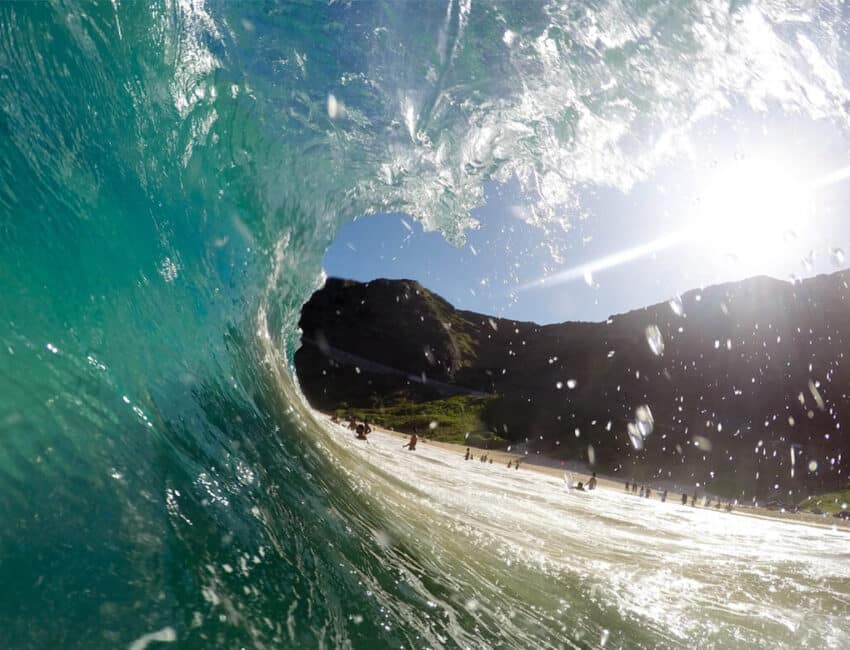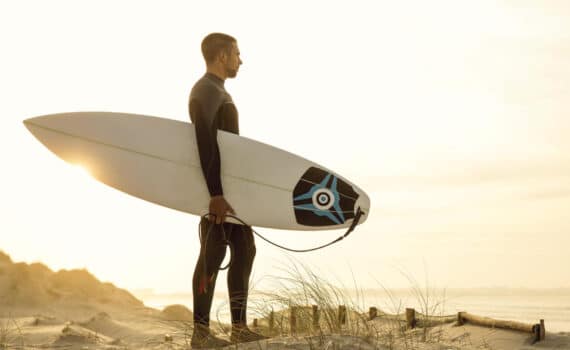Recent statistics show that one-third of all rip current and surf zone fatalities in the U.S. happened during June and July 2023. The numbers reveal an even more striking fact – males made up nearly 90% of these victims.
Contact with a surfer’s own board causes more than 90% of surfing injuries, but surfing safety shouldn’t feel overwhelming. The right knowledge and preparation will help you tackle the waves with confidence and stay safe.
This piece will guide you through every step to become a safety-conscious surfer. You’ll learn about dangerous rip currents and become skilled at proper board handling that will build your water confidence. The guide works great for beginners and experienced surfers who want to refresh their safety skills.
Ready to catch some waves safely? Let’s take a closer look at everything you need to know about surfing safety!
Assessing Your Water Confidence Before Surfing
You must assess your water confidence before paddling out to catch your first wave. Many beginners focus only on board skills without an honest evaluation of their basic comfort and capabilities in ocean environments.
Understanding your swimming abilities
Swimming competency creates the foundations of surfing safety. Expert guidance suggests surfers should swim several times the paddle-out distance of their chosen break without stopping. This means you should swim at least 400 meters unassisted when surfing a break that far from shore.
Think over these vital swimming abilities before you surf:
- Knowing how to tread water or float for at least 15-20 minutes without rest
- Swimming 250-500 meters continuously without touching bottom
- Staying composed when waves toss you around
Note that pool swimming is different from ocean swimming. One experienced surfer points out, “Just because you can swim 50 meters in a pool does not mean you can swim 50+ meters through the surf from the backline to shoreline”. Ocean swimming needs specific techniques and stamina to handle currents, waves, and changing conditions.
Recognizing personal comfort levels in ocean environments
Your psychological comfort in ocean environments is vital beyond swimming ability. A crowded lineup can intimidate surfers of all levels, especially beginners. Your mental state affects your safety and performance substantially.
Ask yourself this key question before entering the water: “If my leash breaks out the back, could I swim in safely and confidently?”. This simple self-check helps you determine if conditions match your current abilities.
On top of that, it helps to observe the environment. Watch the waves for at least five minutes to identify potential hazards like rip currents and assess the crowd. Look for experienced surfers with good board control or beginners who might create additional safety risks.
Most beginners build confidence more effectively when they start in gentler conditions with a sandy bottom. So choosing the right location helps develop water confidence without unnecessary risk.
Setting realistic safety goals
You need achievable goals that gradually expand your comfort zone to progress in surfing safety. Start with an honest assessment of your current skill level and limitations. This self-awareness helps build all future improvement.
Master the fundamentals in controlled environments before you challenge yourself in more demanding conditions. One experienced instructor emphasizes, “You need to push your surfing out of your comfort zone, but you also need to say no and pass on days that seem too dangerous for you”.
Create progressive measures rather than attempting challenging conditions too soon. Each small win builds confidence and competence. A measured approach might include:
- Starting in shallow, gentle waves where you can stand
- Gradually advancing to deeper water as skills improve
- Practicing controlled wipeouts in familiar conditions before encountering them unexpectedly
Note that understanding your limitations isn’t weakness—it’s essential wisdom that keeps you and others safe. The ocean demands respect from everyone, whatever their experience level.
Essential Beach Safety Equipment for New Surfers
New surfers need the right safety equipment before they head into the ocean. Good gear makes your experience better and can save your life when unexpected situations arise in unpredictable waters.
Choosing the right surfboard for beginners
A properly sized surfboard is the most important piece of equipment for new surfers. Professional surfer Josh Kerr says beginners should start with a soft-top surfboard that’s 9 feet or longer to get maximum stability. These boards give you better buoyancy and are more forgiving than other types.
Here’s what you need to look for in your first board:
- Soft-top foam boards between 8-9 feet long give you the best stability and safety
- Bigger boards make paddling easier, help with balance, and catch waves better
- Foam construction reduces your risk of injury during wipeouts
- These cost less than fiberglass boards and need less maintenance
“The biggest mistake people make when they buy a surfboard is that they don’t have an accurate understanding of their skill level,” says one surfing instructor. Many beginners end up buying boards that are too advanced, which slows their progress and can create dangerous situations.
Leash selection and proper attachment
Your surfboard leash keeps you connected to your board and stops it from becoming a dangerous projectile during wipeouts. Think of it as your lifeline in the water.
Pick a leash that matches your surfboard’s length or is slightly longer. Modern leashes now come with quick-release mechanisms that let you detach easily if you get caught on underwater obstacles – something that was once frowned upon.
Always attach your leash to your back foot (right foot for regular stance, left for goofy). The rail saver should touch your board’s rail when pulled to protect it from damage. This setup keeps the leash from tangling around your feet while you paddle or ride waves.
Wetsuit considerations for safety and comfort
Wetsuits do more than keep you warm – they protect you from UV radiation, scrapes, and impacts. They trap a thin layer of water between the neoprene and your skin, which your body heats up to create insulation.
Surfing wetsuits are different from dive suits. They’re built for better shoulder and arm flexibility so you can paddle easily. The neoprene thickness determines how warm and flexible the suit is – thicker suits (5mm+) work best in cold water, while thinner ones (2-3mm) are good for warmer conditions.
A proper fit is vital for safety and performance. Your wetsuit should feel snug but not restrict your movement or breathing. A well-fitted suit keeps excess water from flowing in and out, which helps maintain warmth while letting you move freely.
Sun protection essentials
Surfers often overlook sun protection, yet it’s crucial for safety. Dermatologists point out that surfers get extra UV exposure from both direct sunlight and water reflections, which can boost exposure by up to 50%.
Mineral sunscreen with zinc oxide works well and stays reef-safe. Put it on 15-20 minutes before you hit the water and add more every two hours. UV rays cut through clouds easily – 90% still get through on cloudy days, so you need protection no matter what the weather’s like.
UPF-rated clothing gives you extra protection. “Darker colors generally provide better sun protection as they absorb or block more UV radiation compared to lighter colors,” a dermatologist explains. Tightly woven fabrics block harmful rays better, which makes UPF-rated rashguards great for long sessions.
Quality safety equipment builds the foundation for safe, fun surfing experiences as you gain confidence in the water.
Understanding Ocean Behavior for Safe Surfing
The ocean has its own language, and learning to understand it is significant for surfing safety. You can turn potentially dangerous situations into manageable challenges by becoming skilled at reading its signals.
How to read wave patterns
Wave reading success starts before you touch the water. Take 5-10 minutes to observe from shore and identify patterns and variations. Watch how waves form, where they peak, and how they break. This observation helps you make better decisions about positioning.
The peak (highest part of the wave) suggests where the wave will break first. Watch the steepest angle down from the peak – it shows whether the wave breaks left, right, or both. Waves that have equal height on both sides of the peak typically “close out” (break all at once) and become difficult to ride safely.
Experience will teach you that waves arrive in sets with similar periods between them. You can paddle out between these sets rather than fight through breaking waves.
Identifying dangerous rip currents
Rip currents are powerful, channeled currents that flow away from shore through the surf zone. Waves push water toward the shoreline and create an imbalance that finds the path of least resistance back through breaks in sandbars.
You’ll spot rip currents by looking for:
- Darker patches of water (indicating deeper channels)
- Gaps in the pattern of breaking waves
- Choppy, churning water surface
- Debris or seaweed moving steadily seaward
Note that if you get caught in a rip current, never swim directly against it. Paddle parallel to the shore until you exit the current, then let breaking waves help you return to beach.
Recognizing safe entry and exit points
Your exit strategy needs planning before you enter the water. Some surf breaks make shore return complicated because of rocks, cliffs, currents, or tidal movements.
Safe entry and exit points show regular wave patterns with clear paths to the water. The safety of different breaks depends on tide levels – high tide often covers hazards that low tide exposes.
New locations require consultation with lifeguards or experienced local surfers about potential hazards. A simple conversation prevents dangerous situations, especially at point breaks or reef breaks where timing becomes vital.
Using landmarks to maintain position
Ocean currents will move your position, often without notice until you’ve drifted far from your spot. Land-based reference points help you maintain your position.
This technique, called triangulation, requires you to find and record multiple reference points (buildings, trees, distinctive dunes) to track your coordinates in the lineup. Regular checks of these landmarks ensure you stay on course.
Experienced surfers’ positions and wave breaks relative to your landmarks provide valuable guidance. Currents may move you, but you can quickly paddle back to your optimal position instead of ending up in dangerous areas or missing the best waves.
Mastering Basic Safe Surfing Techniques
Surfing safety starts with the basics that protect everyone in the water. These skills are the foundations that help build all other surfing abilities.
Proper board handling on land and in water
The right way to carry your surfboard can prevent damage and injury. Your board’s tail or nose should never drag along the beach – this will damage the fins and structure. Here are the best ways to carry your board:
- The Classic Grab: Tuck the board under your arm with nose forward and fins toward your body
- The Hip Procedure: Let the inner rail rest on your hip for wider boards
- The Head Carry: Balance the board’s bottom on your head with fins up for longboards
The water demands different handling. Your board should stay perpendicular to breaking waves, not parallel. This stops it from becoming dangerous.
Safe paddling techniques
The quickest way to paddle well is to find your “sweet spot” on the board. Your body weight should make the nose dip slightly underwater or just skim the surface as you paddle. Your body needs to stay centered with feet together – this cuts down on drag.
Your thumbs should enter the water first to move efficiently, and your strokes should stay close to the board. Keeping your fingers slightly apart will boost your stroke power. Smart paddlers adjust their speed based on conditions. They save energy between sets and speed up to catch waves.
How to fall correctly to avoid injury
The right falling technique prevents major injuries. Think of falling backward into the wave as a “wet trust fall” – this protects your vital organs from hitting the board. Your arms should cover your head right away during a fall to avoid head injuries.
The wave’s force isn’t something you can fight. Stay relaxed, hold your breath, and wait for calmer water before coming up. On top of that, shallow water jumps or dives can lead to broken ankles or neck injuries – so avoid them.
Duck diving and turtle rolling for wave navigation
Shortboards need duck diving while longboards need turtle rolling. Duck diving works when you push the nose underwater with your hands, then use your foot to press the tail down under the wave.
Turtle rolling works better for longboards. As the wave comes, flip your board upside down with fins up. Hold the rails firmly near the middle and let your body hang like a sea anchor. Once the wave passes, flip back over and start paddling again.
Building Water Confidence Through Progressive Practice
Building surfing confidence takes methodical practice instead of jumping straight into deep water. Many beginners feel anxious about water, but a well-laid-out progression builds competence and security.
Starting in shallow water
Your experience with water confidence starts in manageable environments. Surf schools structure their training programs to improve essential skills. These include paddling techniques, breath control, and wave negotiation in supportive settings. We practiced in shallow water to:
- Perfect fundamental skills without fear
- Focus on proper technique instead of survival
- Get higher wave count to learn faster
You can catch about 50 waves in a single session near the shore’s whitewater—perfect to develop solid pop-up technique and stance. Yes, it is better to master these fundamentals before moving to deeper waters.
Gradually advancing to deeper areas
A measured approach works best after getting comfortable in shallow water. Note that your wave count drops when moving to unbroken waves. You might catch only 1-2 waves per session at first. This drop is normal and shouldn’t stop your progress.
Look for surf spots with defined channels. These make paddle-outs easier and help save energy instead of fighting through endless whitewater. Regular practice in different conditions helps you understand various wave types.
Practicing controlled wipeouts
Learning to surf means you will wipe out. Practicing controlled falls builds vital confidence to handle unexpected situations. Breath training becomes key preparation in these moments.
You can do static breath holds in calm water or on land to help your body adapt to uncomfortable situations. This skill becomes valuable during underwater hold-downs. Most wipeouts in waves up to double overhead are nowhere near 12 seconds—much shorter than your trained breath capacity.
Stay relaxed when practicing wipeouts. Tension uses more oxygen, while staying calm helps you last longer underwater. Learning how your body responds to stress creates mental toughness for challenging situations.
Conclusion – Surfing Safety
Safe surfing just needs respect, preparation, and continuous learning. A solid foundation for safe surfing adventures starts with an honest look at your swimming abilities, proper gear selection, and understanding how the ocean behaves.
Becoming skilled at surfing safety happens through gradual progression. Each small step builds confidence. You can practice in shallow waters, understand wave patterns and perfect simple techniques. Many experienced surfers still work on these fundamental skills.
Your progress deserves patience, and safety basics should never be compromised. Weather conditions change frequently. Equipment needs maintenance, and skills require regular practice. You can ensure countless enjoyable surf sessions by staying aware of these elements and following proper safety protocols.
The ocean rewards those who show respect and come prepared. This complete safety knowledge will give you the confidence to begin your surf trip safely. See you out in the lineup!


